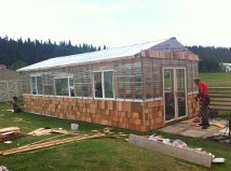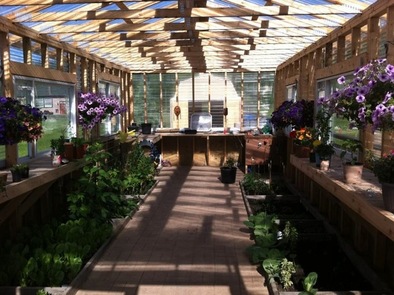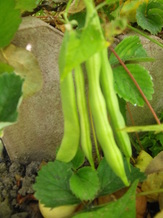  Another Greenhouse Story Our July issue brought to light a little about the solar greenhouses popping up around Calgary. In response to that article, I received a letter from one reader who along with her partner have constructed a rather large one of their own just southwest of the city. Being that Andrea and Carlos are nearer the mountains than us city dwellers, their growing season is that much shorter, and so a greenhouse was the best option for them. The 32 x 12-foot structure (sort of a modified garage or shed) was constructed far more cheaply than any store-bought greenhouse packages, using salvaged and second-hand materials. It also makes use of other pre-existing resources for plant irrigation. According to Andrea, “The structure has 6 windows for ventilation that we sourced on Kijiji from someone who was replacing windows in their home. The entrance door is also a salvaged double glass door from a renovation job. We installed a solar panel provide us with the power to work a fan inside as well as to power a pump for watering. The origin of that water is from our home's sump pump which is quite active. That ground water has served most of our landscape needs and all of our greenhouse watering (an assortment of cisterns that collect rain water take care of the rest).” Additionally, brick pavers have been added to a walkway inside the building in order to capture and hold heat. The past couple of growing seasons have provided a plentiful harvest with more modifications to the greenhouse yet to come. These include insulation and rain water catchment which are likely to further enhance the growing conditions in this indoor food garden. Thank you to Andrea and Carlos for sharing, and may this, and all your future growing seasons be bountiful!  Nitrogen Fixers—Amazing Plants If you have been gardening for a little while, you are likely aware that nitrogen is a key component for plant growth. If you are attempting to garden without the use of fertilizers (synthetic or otherwise), you’re probably already aware of the importance of including a few nitrogen-“fixing” plants in your landscape. Some examples of these plants include caragana, sea buckthorn, clover, all types of beans, peas, peanuts, soybean, groundnut, and other leguminous plants (as well as a few non-leguminous plants). A nitrogen fixer is a special type of plant which has tiny nodules on its roots which host a kind of bacteria whose key role is to convert nitrogen that the plant draws in from the atmosphere into a useable form for the plant. This nitrogen is also made available to surrounding plants either through the soil or when the N-fixer has decayed. A second intriguing thing about these plants is how they relate to humans. Most non-nitrogen-fixing plants provide our diet with sugars or carbohydrates of some type. Chemically speaking, we are talking about a combination of carbon, hydrogen and oxygen. When a fourth element of nitrogen is added, a protein (or amino acid) is created, making any food harvested from Nitrogen fixers a good source of protein. It would be difficult to obtain a healthy diet (especially if you are vegan or vegetarian) without these plants. Remember to always include these plants in any landscape, especially where you would like mother nature to do your fertilizing for you! ______________________________________________________________________________________ Reminder! Don't Forget Permaculture Tour 2012 - Click Here for Tickets!
1 Comment
|
Author:Ted Bahr is the founder of Prairie Sage Permaculture. MORE Archives
April 2023
Categories
All
|

 RSS Feed
RSS Feed
